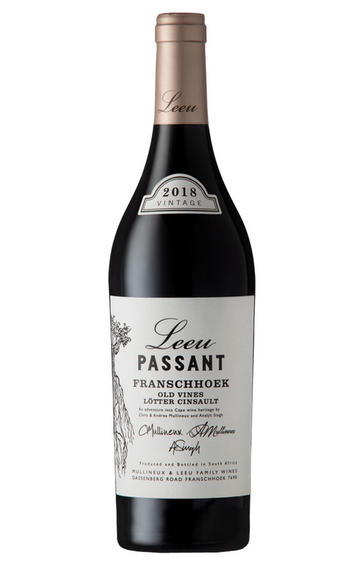
2018 Mullineux & Leeu Family Wines, Leeu Passant, Lötter, Old Vines, Cinsault, Franschhoek, South Africa
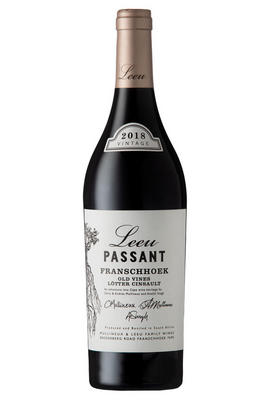
Critics reviews
The 2018 Old Vines Lötter Cinsault has a gorgeous bouquet of lifted red cherries, crushed strawberry and a touch of shoe leather, all very well defined and focused. The palate is well balanced with a lightly spiced entry, a fine bead of acidity and a caressing texture. Chinese five-spice and notes of sage appear toward the complex finish. This is an excellent Cinsault from Andrea and Chris Mullineux.
Drink 2021 - 2035
Neal Martin, Vinous.com (February 2021)
Made from vines originally planted in 1932, the dry-farmed 2018 Leeu Passant Old Vines Lotter Cinsault displays a classic ruby core and aromas of dark cherry, plum skin, dusty black raspberry and hints of wild brush and dried herbs. Medium to full-bodied, the palate is spicy with dusty red fruit and reminds me of a young Châteauneuf-du-Pape, with subtle baking spices, rocky mineral tension and lifted structure with firm tannins across the mid-palate. Ending with a tightly wound finish, this should easily last until its 10th birthday. This is an absolutely delightful, age-worthy and food-friendly Cinsault. Bravo!
Drink 2021 - 2030
Anthony Mueller, Wine Advocate (Oct 2021)
Drink 2021 - 2024
Matt Walls, Decanter.com (September 2021)
About this WINE
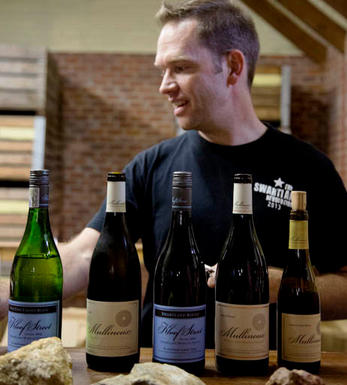
Mullineux & Leeu Family Wines
Mullineux & Leeu Family Wines is one of the stand-out producers in South Africa's budding Swartland region. Winemakers Chris and Andrea Mullineux’s ambition is to bottle wines that are a true expression of the Swartland, and all steps of their winemaking process are taken with this in mind. They work closely with a select group of growers who follow sustainable, reasoned farming practices, as well as owning vineyards at their Roundstone Farm in Riebeeksrivier.
In the cellar, apart from minimal amounts of sulphur, nothing is added to or removed from the wine. They do not make use of any yeasts, acids, tannins, enzymes, or fining and filtering agents. “Leeu” (Afrikaans for “lion”) was added to the name recently to recognise the contribution of a new investor to the project.
Apart from their wonderful Syrah, Chenin Blanc-based white blend and a super-rich Straw Wine made from air-dried Chenin Blanc, fermented and matured in old barriques, Mullineux now has a range of spectacular single-terroir Syrah and Chenin Blanc wines, each of which illustrates the amazing potential of the differing Swartland soils. Volumes of the single-vineyard wines are tiny, so availability is extremely limited.
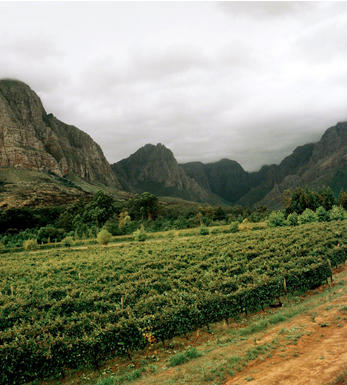
Swartland
After Stellenbosch, the west coast district of Swartland (25 miles due north of Cape Town, between the towns of Malmesbury and Piketberg) now ranks as the Cape's most exciting wine-producing district.
Settled initially by nomadic Khoikhoi from Namibia, the Dutch brought trade and vines to the region in the 17th century. Viticulture was developed only more recently.This contrasts with an ancient geology which has brought a mix of shale, arenite sandstone and granite soils air-conditioned by the Atlantic Ocean nearby.
Chenin Blanc and Shiraz seem to do best, as exemplified by the wines of Eben Sadie and Mullineux.
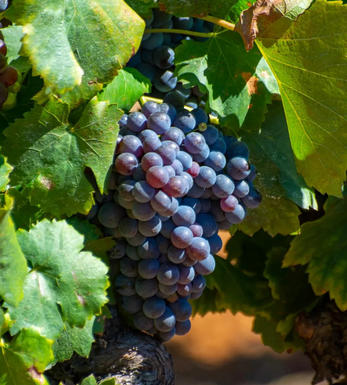
Cinsault
Cinsault (pronounced "sin-so") is a red grape variety known for its versatility and contributions to various wine regions worldwide. It has a rich history, primarily in the Languedoc region of southern France, but it has spread to many other wine-producing areas due to its adaptability to different climates.
Cinsault grapes are medium-sized with thin skins, typically dark blue to black in colour. The vines are hardy and drought-resistant grapevine, making them suitable for warm and arid climates. They are particularly well-suited to Mediterranean regions and thrive in areas with hot summers.
While Cinsault is mainly used in red wine production, it is also sometimes used in rosé wines, adding light and fruity character. It is often blended with other grape varieties to enhance the wine profile.
The variety tends to exhibit a range of flavours, including red berries, cherries, and sometimes a hint of spices. When used in rosé wines, it can bring out more floral and watermelon notes.
Tannins are typically on the lower side, which can make them more approachable and enjoyable in their youth. The variety is often used in blends to soften and round out more tannic grape varieties.
Cinsault has been a key component in traditional blends in southern France, such as in Châteauneuf-du-Pape wines. Over time, it has gained popularity in other wine regions as winemakers recognize its potential for producing high-quality wines.


Buying options
Add to wishlist
Description
The 2018 Old Vines Lötter Cinsault has a gorgeous bouquet of lifted red cherries, crushed strawberry and a touch of shoe leather, all very well defined and focused. The palate is well balanced with a lightly spiced entry, a fine bead of acidity and a caressing texture. Chinese five-spice and notes of sage appear toward the complex finish. This is an excellent Cinsault from Andrea and Chris Mullineux.
Drink 2021 - 2035
Neal Martin, Vinous.com (February 2021)
wine at a glance
Delivery and quality guarantee